Historic Courthouse Mural
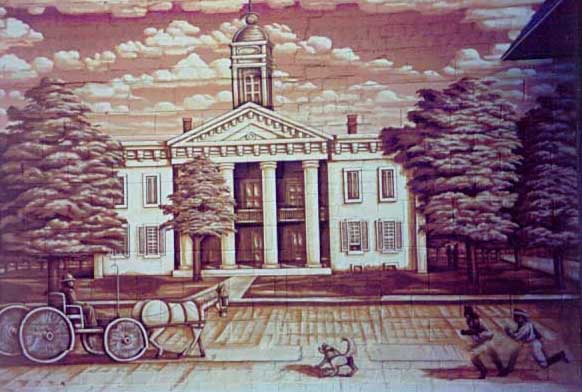
Created in monochromatic tones, this mural was painted by Rebecca Sawyer Spoon from an original pen-in-ink drawing by Jim Donahoo. This mural depicts the second Coles County Courthouse on the square as it appeared between 1866 and 1898. The courthouse is made up of the 1835 Courthouse with four additions made over subsequent decades. The first addition went up in 1858, and the other three were completed in 1866, which marked the transition of the structure into the one illustrated in the mural. If we look at the series of courthouses that were constructed over the past one-hundred and seventy years, we can observe a complex and interesting history involving just one small lot in the center of the city.
As the original settlers of Charleston moved into the area, they constructed temporary log structures for shelter. The first settlement, (in what is now the square), was composed of a series of log cabins. In fact, the first courthouse in Charleston was a simple log 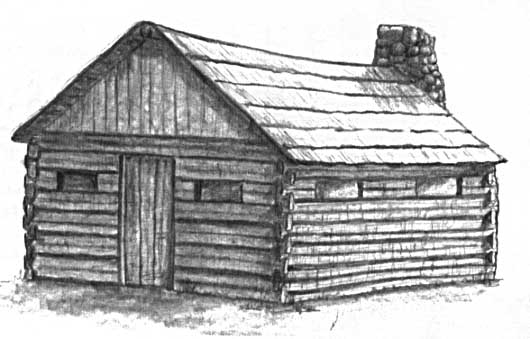 structure portrayed in this drawing. Built in 1832, this log structure only saw three years of service as the local courthouse. Construction was slow in 1832, because some of the men involved in its construction went off to fight in the Blackhawk War that summer. When completed, the log courthouse stood between Jackson Street and Columbus Street, (now 6th and 7th), not in the square.
structure portrayed in this drawing. Built in 1832, this log structure only saw three years of service as the local courthouse. Construction was slow in 1832, because some of the men involved in its construction went off to fight in the Blackhawk War that summer. When completed, the log courthouse stood between Jackson Street and Columbus Street, (now 6th and 7th), not in the square.
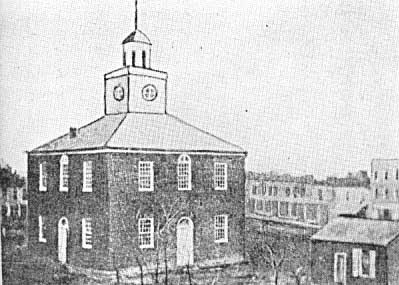
In December of 1832, county commissioners signed an agreement with Leander Munsel, from Edgar County, for the construction of a county courthouse in the (then empty) Town Square. Munsel hired James Wiley and several of his sons to do the brick work. The new courthouse was completed by October of 1835, nearly a year ahead of schedule. It was one of the courthouses that Abraham Lincoln practiced law in during the 1840s. After its completion, the commissioners auctioned off the old log courthouse and the lot on which it resided. The small building next to the courthouse in the picture was the county clerk's office.

Beginning in 1858, additions to the courthouse began to appear (first addition depicted in photograph on the right). These additions slowly converted the original 1835 structure into a whole new building. The progress was temporarily put on hold because of the outbreak of the Civil War. But in 1866, construction resumed and the new Coles County Courthouse was completed with the addition of the final three sections.
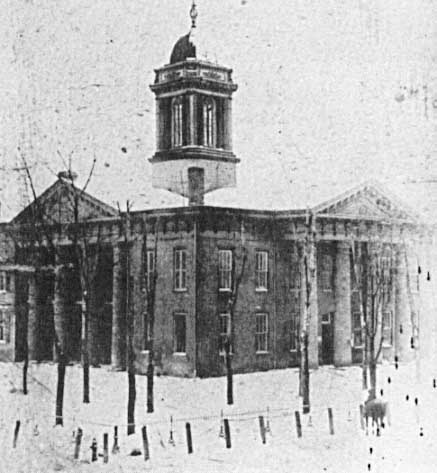
This photo (above), taken around 1866, portrays the courthouse after the additions were completed. This is the building that is depicted in the mural. The new Classical Revival courthouse consisted of columns that supported Classical Revival pediments on the east and west sides, while the north and south sides contained monumental porticos and Italianate brackets in cornices. This building served as the county courthouse until it was razed in 1898, as construction of yet another courthouse began. The decision was made by the County Board of Supervisors without the consensus of the people. Many perceived it as a gross legal and ethical violation.
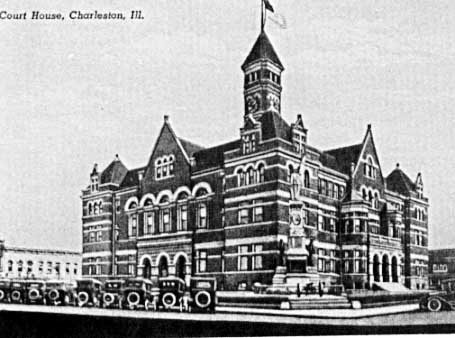
This building should look familiar. Dedicated in September of 1900, this courthouse still serves Coles County. Constructed in a Richardsonian Romanesque style, this structure exceeds the previous structures in size and aesthetics. It stands today as a symbol of integrity and authority.
Questions to guide further research on the courthouse could include: How have the changing styles of the courthouse been influenced by national changes in aesthetics? How can the courthouse be perceived as the physical and symbolic center of Coles County? What is the historical significance of the development of the courthouse square in Charleston?









